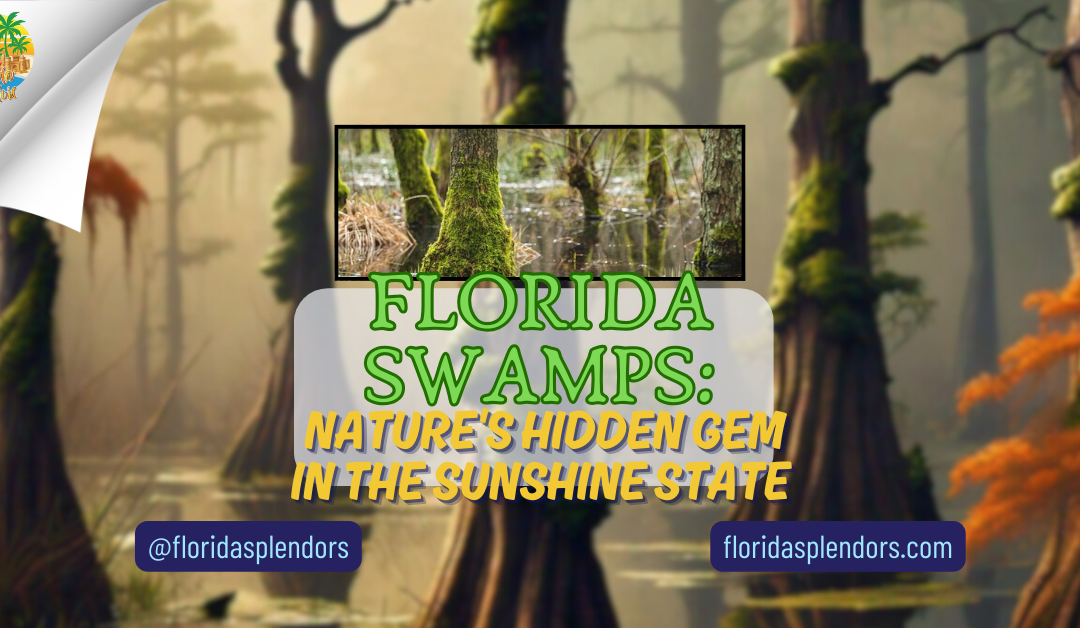==================
Florida Splendors is supported by our audience. When you purchase through one of our links, we may earn a small affiliate commission. As an Amazon Associate I earn from qualifying purchases. Your cost is not affected.
Florida swamps are often overlooked in favor of the state’s famous beaches and theme parks, but they hold an undeniable allure for nature lovers. With their eerie cypress trees draped in Spanish moss and waters teeming with wildlife, these wetlands offer a glimpse into the Sunshine State’s raw, untamed side. Beyond the captivating fauna, Florida’s swamps are home to unique flora and breathtaking landscapes.
The dense foliage and mirror-like waters create an enchanting, almost mystical atmosphere. Whether you’re a seasoned adventurer looking for a thrilling paddle through mangrove tunnels or a casual hiker seeking the tranquility of shaded boardwalks, these wetlands promise an experience unlike any other. Dive in and discover why Florida swamps are truly nature’s hidden gem.
Exploring Florida’s Swamps: The Untamed Wilderness of the Sunshine State
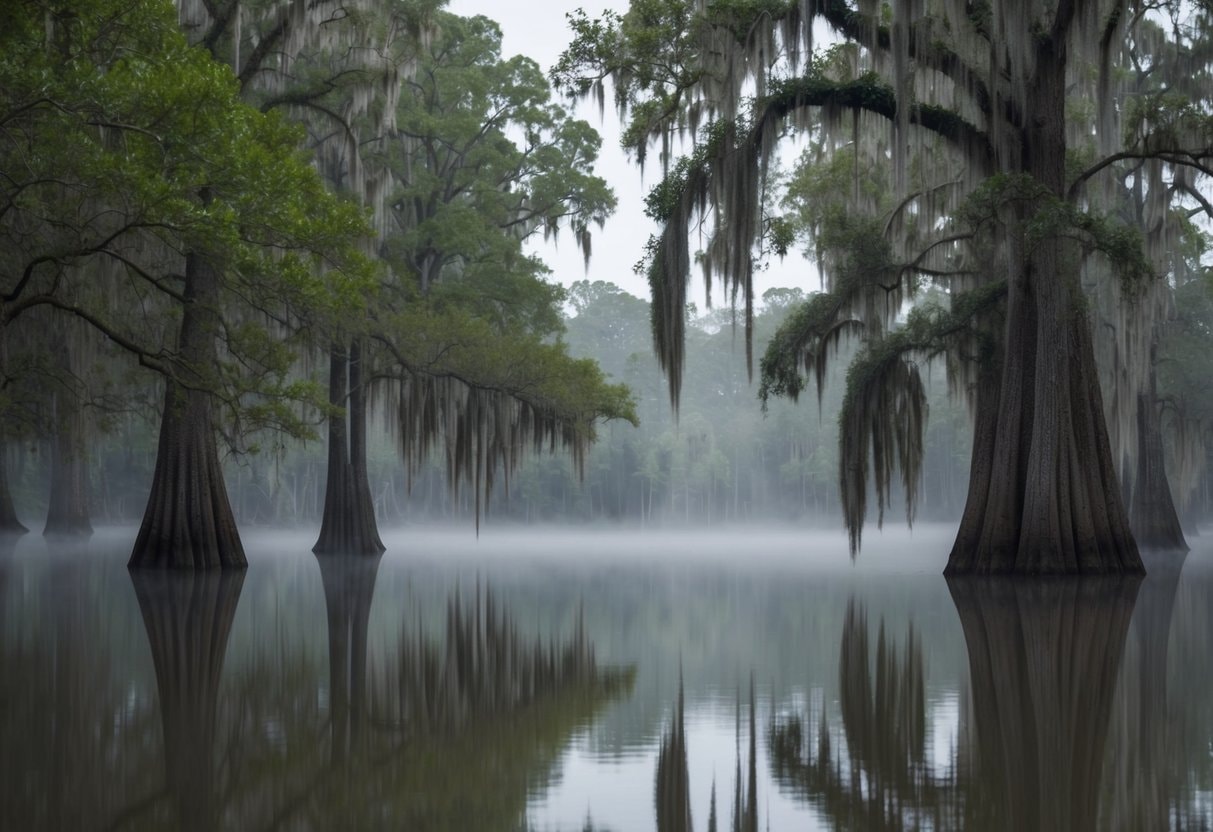
When I think of Florida, swamps are not the first thing that comes to mind. Yet, on my first visit, I discovered their hidden beauty. The still waters, framed by cypress trees and draped in Spanish moss, told a story of tranquility and life. As I waded through the thick vegetation, I deeply respected these unique ecosystems. Swamps are nature’s unsung heroes. They filter our water, provide homes for diverse wildlife, and act as natural flood controls. In this article, I’ll share my journey through Florida’s swamps and highlight why they are vital. Let’s explore these hidden gems together.
Florida swamps are unique wetland ecosystems that cover large parts of the state. These watery landscapes are home to many plants and animals found nowhere else. Florida swamps are wetland habitats with high water tables, lots of rain, and flat land. The most famous Florida swamp is the Everglades. This huge wetland covers much of South Florida. It has sawgrass marshes, mangrove forests, and slow-moving rivers. The Everglades is home to alligators, panthers, and many rare birds.
Other big swamps in Florida include Big Cypress and Okefenokee. These swamps have cypress trees, wild orchids, and many kinds of fish. People can visit these areas to see nature up close. Visitors can go hiking, canoeing, or take guided tours to learn about swamp life.
Key Takeaways
- Florida swamps are special wetlands with unique plants and animals.
- The Everglades is the largest and most well-known swamp in Florida.
- Swamps face threats but also offer chances for nature tourism and learning.
Overview of Florida Swamps
Florida’s swamps are unique wetland habitats that are vital to the state’s ecology. These areas are home to diverse plants and animals and help maintain water quality.

Geographic Distribution
Swamps cover large parts of Florida. They’re found everywhere, from the panhandle to the southern tip. The Everglades is one of the most famous swamp areas. It stretches across South Florida.
Many swamps form in low-lying areas where water collects. Rivers and lakes often have swamps around their edges. Coastal areas have special types of swamps too.
Florida’s flat land and high rainfall make it perfect for swamps. The state’s high water table also helps swamps form and stay wet.
Types of Swamps
Florida has several kinds of swamps. Each type has its mix of plants and animals. Cypress swamps are very common in Florida. Tall cypress trees grow in these wet areas. Their knees stick up out of the water. Hardwood swamps have trees like maple and oak. These swamps might dry out for part of the year.
Mangrove swamps grow along the coast. These trees can live in salty water. They protect the shore from storms. Strand swamps form in long, narrow areas. Water flows through them slowly.
Importance to Ecosystems
Swamps are key parts of Florida’s nature. They clean water as it moves through them. This helps keep rivers and lakes healthy. Many animals live in swamps. Fish, birds, and alligators all call swamps home. Some rare animals can only live in these wet places.
Swamps soak up extra water during storms. This helps stop flooding in nearby areas. They also slowly release water during dry times. People use swamps too. They’re great for activities like fishing and bird watching. Swamps also provide water for towns and farms nearby.
Key Swamps of Florida
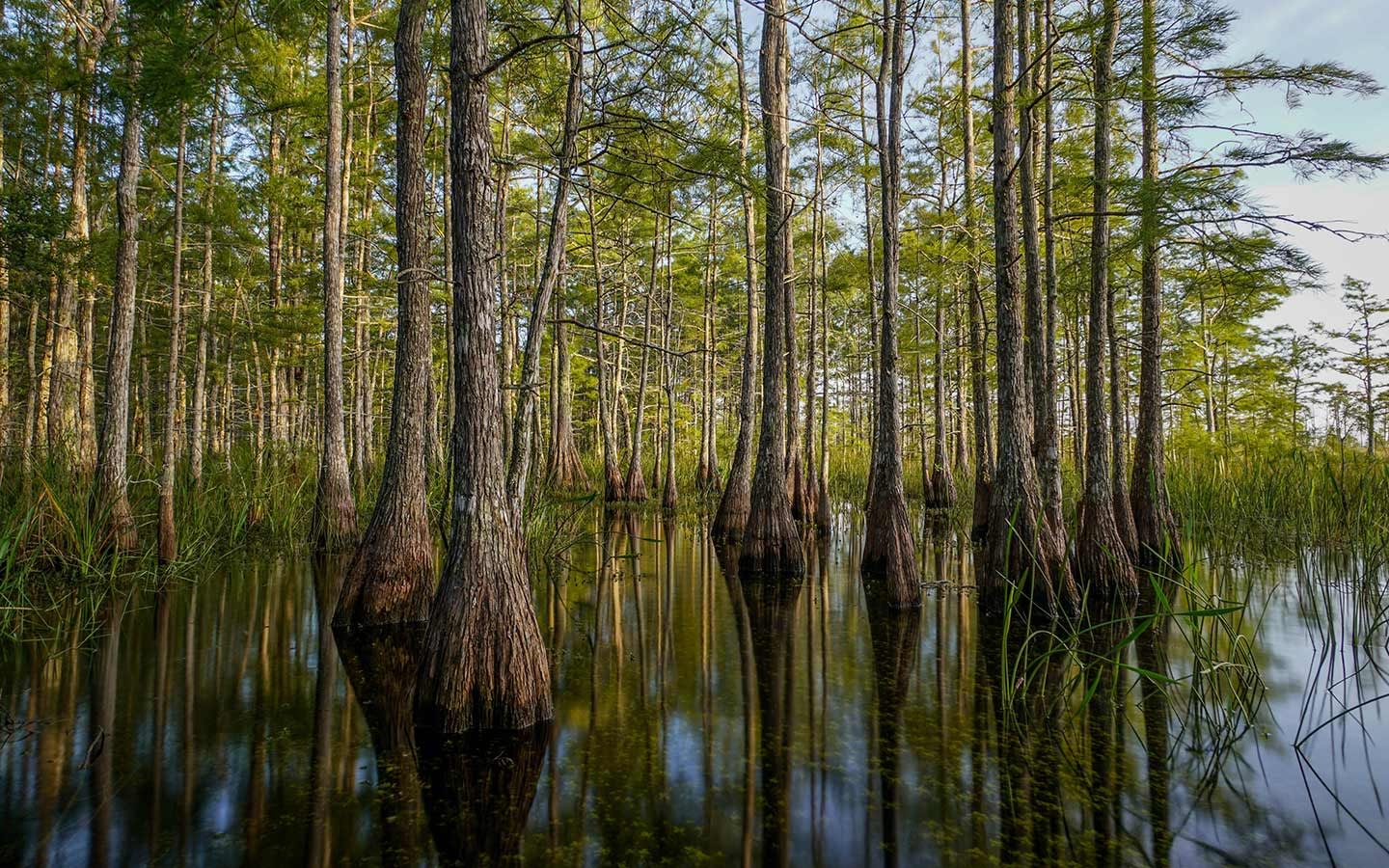
Florida swamps are home to several important wetland areas that are vital to the state’s ecosystem. These Florida swamps provide habitat for diverse wildlife and help filter water. Let’s look at some of the key swamp areas in Florida.
The Everglades
The Everglades is a huge wetland in south Florida. It covers about 1.5 million acres. This area is known as the “River of Grass” because of its sawgrass marshes. The Everglades is home to many animals. Alligators, panthers, and manatees live here. It also has over 360 bird species. This swamp faces some big problems. Water pollution and development threaten its health. Efforts are ongoing to restore and protect the Everglades.
Big Cypress Swamp
Big Cypress Swamp is next to the Everglades. It covers over 729,000 acres. The swamp has a mix of wetlands and forests. Many plants and animals call Big Cypress home. It has cypress trees, orchids, and bromeliads. Animals like Florida black bears and red-cockaded woodpeckers live here too. Big Cypress National Preserve protects much of this swamp. Visitors can explore the area on foot, by canoe, or on scenic drives.
Okefenokee Swamp
The Okefenokee Swamp is mostly in Georgia, but part of it extends into Florida. It’s one of the biggest swamps in North America. This swamp is known for its unique mix of water and fire. It has dark, tea-colored water from decaying plants. Wildfires are common and help maintain the ecosystem. The Okefenokee is home to alligators, black bears, and many bird species. Visitors can enjoy boat tours, fishing, and hiking.
Fakahatchee Strand Preserve
Fakahatchee Strand Preserve is in southwest Florida. It’s known as the “Amazon of North America” because of its lush plant life. This swamp is famous for its orchids. It has 44 native orchid species. The rare ghost orchid grows here. Fakahatchee has a boardwalk for visitors. People can see alligators, birds, and maybe even a Florida panther.
Corkscrew Swamp
Corkscrew Swamp is in southwest Florida. It’s home to North America’s largest remaining stand of old-growth bald cypress. This swamp has a 2.25-mile boardwalk. Visitors can see alligators, otters, and many bird species. Corkscrew Swamp is an important nesting site for wood storks. These big wading birds are threatened in Florida.
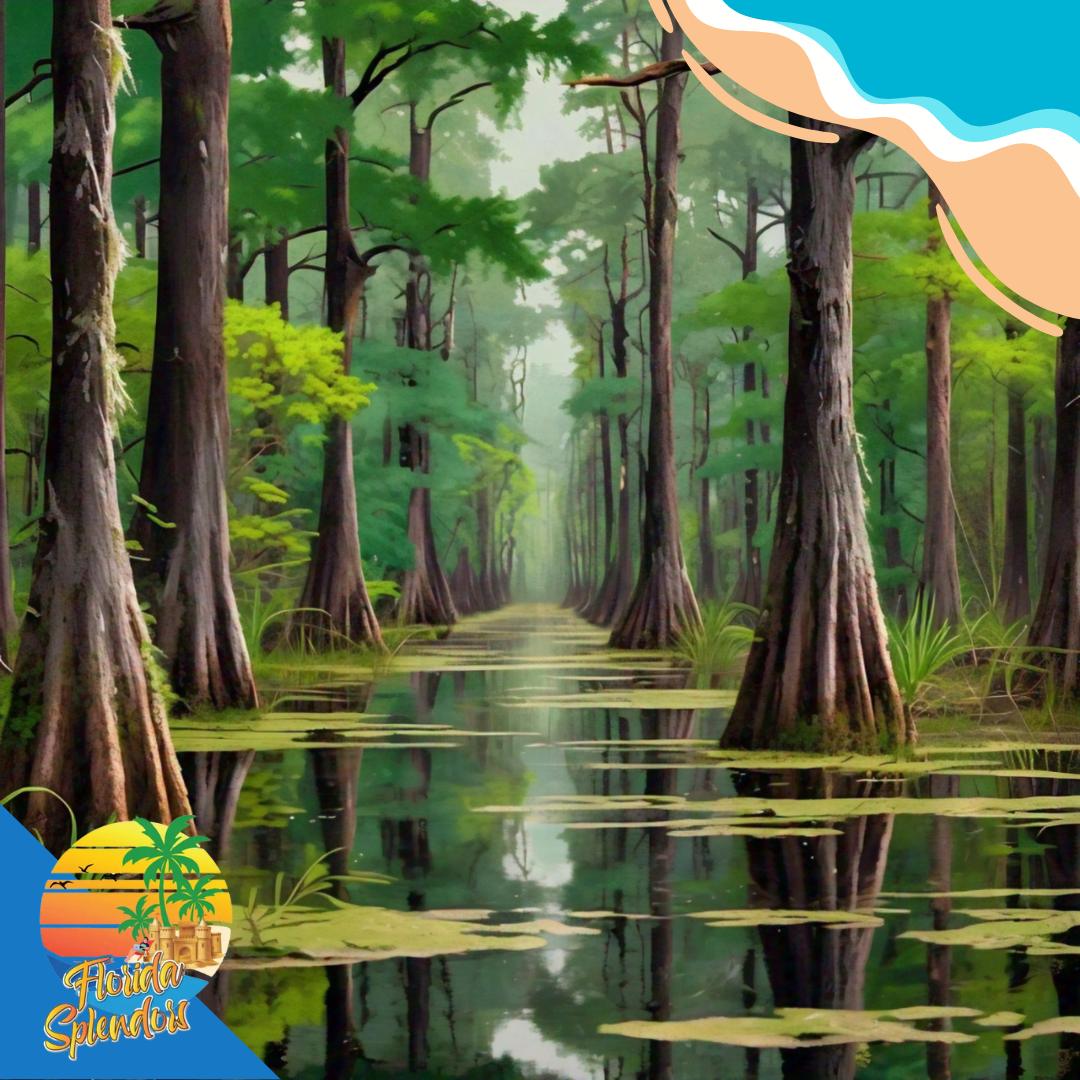
Did You Know?
Florida swamps store massive amounts of carbon. The Okefenokee Swamp alone holds about 120 million metric tons of carbon. Swamps help prevent floods and filter water. They’re crucial for maintaining Florida’s ecological balance.
Dive into the wild with this video on exploring the Florida swamps and their hidden wonders.
By: Zeth
Flora and Fauna
Florida swamps are home to a rich variety of plants and animals. These wetlands support unique ecosystems with many rare and endangered species.
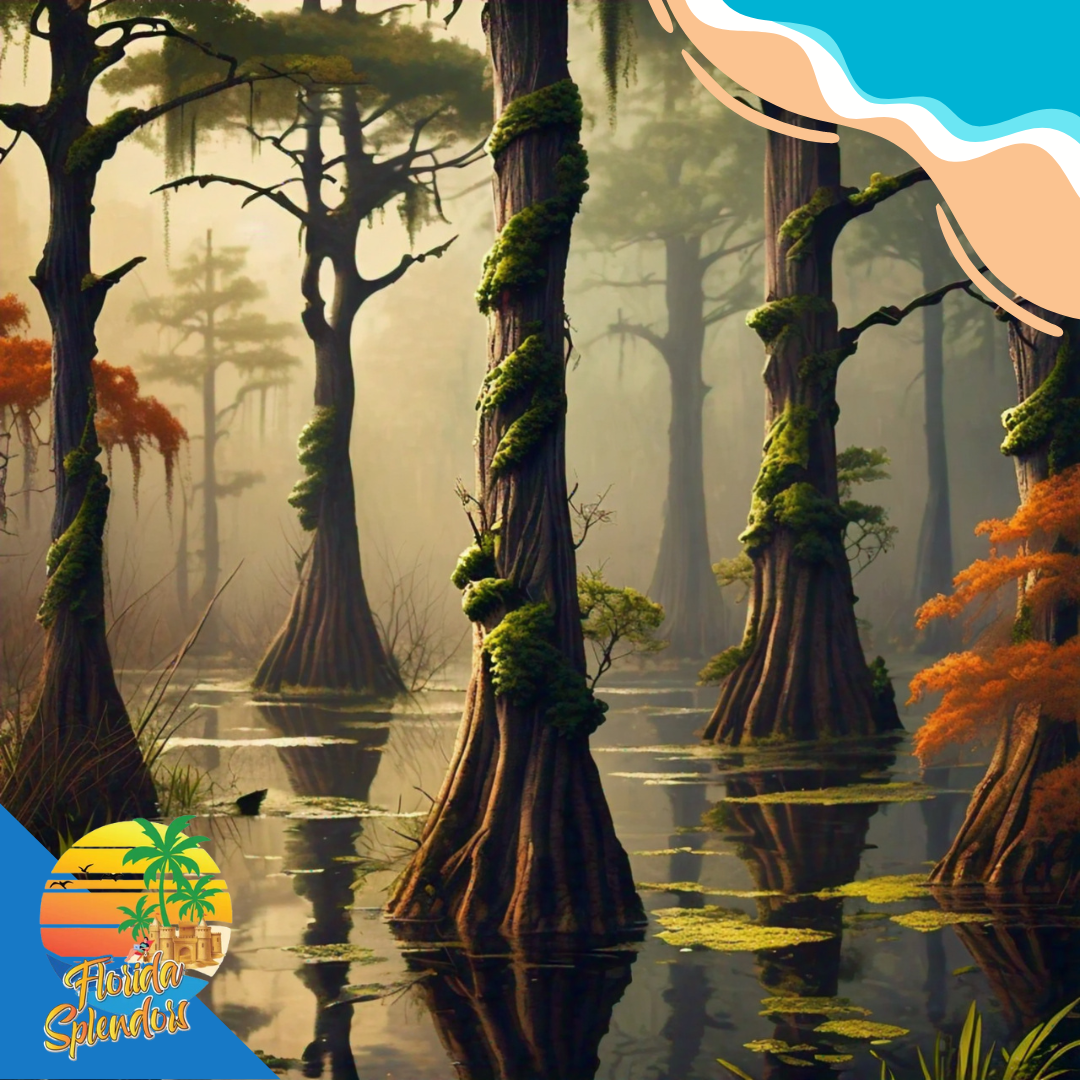
Plants in Swamps
Cypress trees are a key feature of swamps in Florida. Bald cypress can grow up to 150 feet tall in river swamps. Pond cypress is common in still waters. Sawgrass is another important plant, forming vast “prairies” in some areas.
Mangroves thrive in coastal swamps. These trees have special roots that help them live in salty water. They protect the coast from storms and provide homes for many animals. Other plants found in swamps include:
- Ferns.
- Orchids.
- Bromeliads.
- Water lilies.
These plants help create the unique look and feel of swamp habitats.
Wildlife Habitats
Swamps are great places for animals to live. The mix of water and land creates many different homes for wildlife. Birds love swamps. Herons, egrets, and wood storks wade in shallow waters to catch fish. Eagles and ospreys build nests in tall trees. Alligators are famous swamp residents. They swim in the water and bask on sunny banks. Turtles share the water with fish like bass and catfish. On land, many mammals call the swamp home. Deer, raccoons, and opossums roam the drier areas. Even Florida panthers sometimes visit swamps to hunt.
Endangered Species
Some animals in swamps are in danger of disappearing. The Florida panther is one of the rarest animals in the state. Only about 120-230 are left in the wild. Wood storks are big birds that need swamps to survive. They’re listed as threatened because many swamps have been drained. Other endangered animals in Florida swamps include:
- American crocodiles.
- West Indian manatees.
- Snail kites.
Plants can be endangered, too. The ghost orchid is a rare flower that grows in swamps. It’s very hard to find and needs special care to survive. Protecting swamps helps these rare plants and animals. When we save swamps, we give these species a better chance to thrive.
Environmental Concerns and Conservation

Florida swamps face serious threats, but people are working to protect these important ecosystems. Florida swamps also play a key role in fighting climate change.
Threats to Swamp Ecosystems
Florida’s swamps are in danger. Draining wetlands for farms and houses has hurt many areas. This changes the flow of water that swamps need. Rising sea levels are also a big problem. Saltwater is moving into freshwater swamps. This kills plants and animals that can’t live in salty water.
Pollution from farms and cities harms swamp ecosystems, too. Extra nutrients in the water cause algae to grow too much. This uses up oxygen that fish and other creatures need. Invasive species are another threat. Plants and animals from other places can take over swamps. They push out native species that belong there.
Conservation Efforts
People are working hard to save Florida’s swamps. Groups like The Nature Conservancy are fixing drained wetlands. They help store more freshwater naturally. Scientists are finding ways to clean polluted water before it reaches swamps. This helps keep ecosystems healthy.
Laws now protect many swamp areas. People can’t build on or damage these places. This gives plants and animals a safe home. Efforts to remove invasive species are ongoing. Teams work to take out problem plants and catch non-native animals.
Role in Climate Regulation
Swamps are nature’s climate helpers. They soak up lots of carbon dioxide from the air. This helps slow down global warming. Swamps also protect against extreme weather. They act like sponges during heavy rain. This stops flooding in nearby areas.
The plants in swamps clean the air we breathe. They catch dust and other harmful stuff. Swamps cool the area around them. The water and plants together lower temperatures. This is helpful as the world gets warmer.
Florida Swamps: Recreation and Tourism
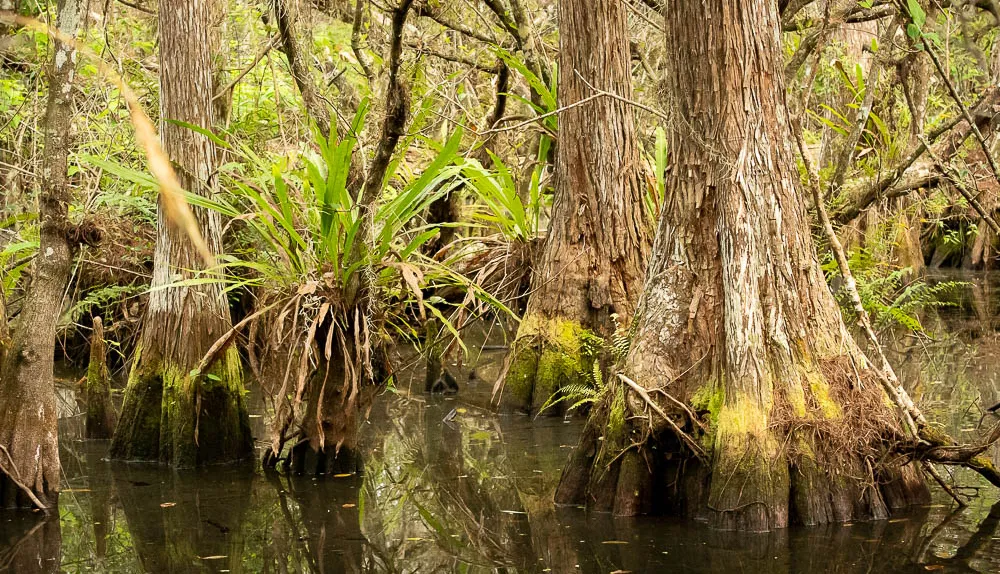
Florida’s swamps offer exciting ways to enjoy nature. Visitors can explore these unique ecosystems through guided tours and outdoor activities.
Eco-Tourism Opportunities
Big Cypress National Preserve is a top spot for eco-tourism in Florida. It covers over 720,000 acres of swampland. Guided tours help people learn about the plants and animals that live there. Many swamps have boardwalks for easy viewing. These let visitors see alligators, birds, and rare plants up close. Some tours use boats to go deeper into the swamp. Night tours are popular, too. They show how the swamp changes after dark. Visitors might see owls, frogs, and other nighttime creatures.
Recreational Activities
Swamps in Florida are great for outdoor fun. Hiking is a common activity. The Van Fleet State Trail lets people walk or bike near swamps for 29 miles. Canoeing and kayaking are exciting ways to explore. Paddlers can go through narrow water paths and see wildlife up close.
Fishing is also popular in swamp areas. Many swamps have spots where people can catch bass and other fish. Bird watching draws many visitors. Swamps are home to herons, egrets, and other interesting birds. Some areas allow hunting during certain times of the year. Hunters must follow strict rules to protect the swamp ecosystem.
Cultural Significance
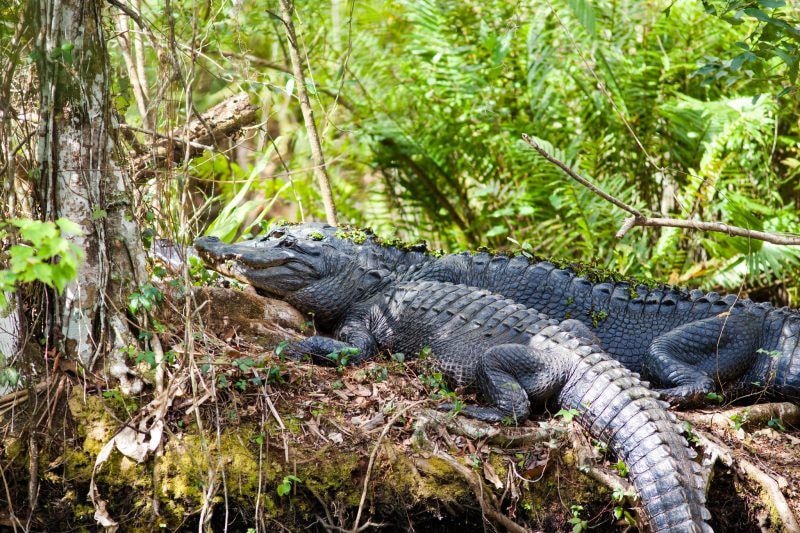
Florida swamps have shaped local culture and inspired scientific study. These unique ecosystems play a key role in folklore and serve as living labs for researchers.
Swamps in Folklore and History
Florida’s swamps have long been part of local stories and myths. Native American tribes viewed them as sacred places full of spirits. Early settlers saw swamps as scary and dangerous. Tales of monsters and ghosts living in the murky waters became popular.
Over time, swamps gained a new image. They became symbols of Florida’s wild beauty. Artists like the Highwaymen painted swamp scenes, showing their charm. Today, swamps are part of Florida’s identity. They appear in books, movies, and TV shows about the state. People now see them as special places to protect.
Education and Research
Florida swamps are outdoor classrooms. Students and scientists come to learn about plants, animals, and ecosystems. Researchers study swamp habitats to understand how they work. They look at how water moves and how different species live together.
Swamps help teach about climate change. Scientists track how rising seas affect these areas. This work helps plan for Florida’s future. Many schools take field trips to swamps. Kids learn about nature and why caring for these spaces is important. Swamp education helps create a new generation of nature lovers.
Check out this video on fishing in hidden Florida swamps for big catches.
By: Fishing With YakPak
Florida Swamps: Unveiling the Untamed Beauty of the Sunshine State
Florida swamps are nature’s hidden gems, offering a glimpse into the wild, untamed side of the Sunshine State that many overlook. Beyond their mysterious beauty, with towering cypress trees and reflective waters, these wetlands are vital ecosystems that support a wide range of unique flora and fauna. From the iconic Everglades to the lush Big Cypress and Okefenokee swamps, these areas are home to endangered species like the Florida panther and rare plants like ghost orchids. The ecological importance of swamps cannot be understated—they help filter water, prevent floods, and store carbon, playing a crucial role in Florida’s environmental health.

Florida swamps provide visitors a chance to explore nature through eco-tourism and recreational activities like hiking, bird watching, and kayaking. Guided tours, boardwalks, and nighttime excursions allow people to experience the enchanting atmosphere of these wetlands up close. Beyond recreation, these swamps hold cultural and historical significance, featuring in local folklore and serving as key subjects for research and education. As conservation efforts continue to protect these invaluable habitats, Florida’s swamps remain a remarkable natural treasure worth exploring and preserving for future generations.
Frequently Asked Questions
Florida swamps are unique ecosystems with rich biodiversity. They attract visitors and nature lovers from all over the world. Here are some common questions people have about these fascinating wetlands.
What is the Most Famous Swamp in Florida?
The Okefenokee Swamp is arguably the most famous swamp in Florida. It spans the border between Florida and Georgia. This massive wetland covers hundreds of thousands of acres. It’s known for its diverse wildlife and unique ecosystem.
Where Can I Find a Map of Florida's Swamps?
A detailed map of Florida’s wetlands, swamps, and coastal waters is available online. It shows the distribution of freshwater marshes and swamps across the state. These maps help people understand the extent of Florida’s wetland ecosystems. They’re useful for both researchers and nature enthusiasts.
Which Swamps in Florida Are Best for a Visit?
Big Cypress National Preserve is a great swamp to visit in Florida. It offers unique wildlife viewing opportunities. The preserve is home to many endangered species. Visitors can enjoy hiking, bird watching, and guided tours.
Excited to Explore Florida’s Best-Kept Secrets?
Become a part of the Florida Splendors community and dive into endless inspiration and excitement! Find hidden gems, connect with like-minded adventurers, and embrace your love for the Sunshine State. Whether you’re paddling through serene waters, lounging on beautiful beaches, or wandering vibrant cities, we’ve got something for everyone!
Follow us on:
Let’s experience Florida’s most unforgettable adventures together!

